Fleas, rats, and plague
1/39
There's no tags or description
Looks like no tags are added yet.
Name | Mastery | Learn | Test | Matching | Spaced |
|---|
No study sessions yet.
40 Terms
Fleas
Order Siphonaptera
15 families
Most fleas of medical importance in Family Pulicidae.
2,500 species
Adults are laterally compressed, wingless, ectoparasites.
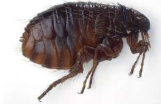
Fleas undergo a _______.
Holometabolous (complete) life cycle
Egg, larva (3 instars) pupa, adult
Pupa spins a cocoon using bits of debris from surroundings.
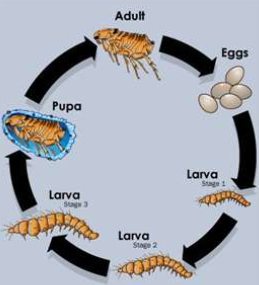
Fleas have _______.
hindlegs are adapted for jumping
Adults fleas eat on blood while larvae ______.
eat blood-rich adult excrement (“flea dirt”), other larvae, organic material in nest.
Most are parasites of mammals.
Some parasitize birds (100 species)
Some are “attached” species
Stick tight flea – Echidnophaga gallinacea
Chigoe flea – Tunga penetrans
Tunga penetrans
Chigoe flea, sand flea
Mated female flea becomes embedded in the skin.
Host skin grows over mated female.
Gravid female grows to the size of a pea.
Develops several dozen eggs.
Mature eggs and young larvae are extruded through the wound to develop on the ground
Severe infestations of the chigoe flea may lead to _______.
amputation.
South American distribution.
Cat Flea – Ctenocephalides felis
Adult female often lays her eggs on the host, but they roll off.
Egg, larva, and pupa are found in the den or nest of the host animal.
Larvae are general feeders, blood, feces, cast skins.
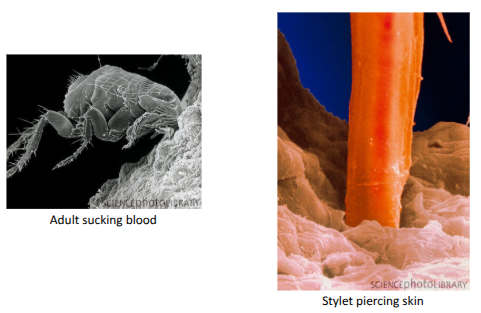
Life stages of Cat Flea
Eggs
Fragile, hatch in 1-2 days
Larvae
11-12 days for larval development.
Pupae
7 days or extended quiescence up to 1 year.
Adults
Starved conditions = 38 days
Fed conditions = 100-125 days
Host specificity with fleas vary ______.
by species
The cat flea is found commonly on ______.
dogs in N. America. It is more common on dogs than the dog flea.
The dog flea is most common on ______.
dogs in the UK
Ctenocephalides canis
Pulex irritans
the human flea, occasional problem for domestic animals such as swine.
Echidnophaga gallinacea
stick tight flea, poultry
Medical Importance of Fleas
Irritation and discomfort to humans and land animals.
Reaction to bite may be severe.
Infestation of home may be associated with a pet.
Fleas in home may also be due to rodent nests.
Fleas are _______.
Intermediate hosts for dog and rodent tapeworms occasionally infesting humans.
Double-pored dog tapeworm, Diplydium caninum.
Vectored by cat and dog fleas.
Eggs in feces are ingested by larval flea.
Occurs in humans if flea is ingested, usually children.
Cat Flea pupation sites in home
carpet
Vacuuming targets pupae
As effective as permethrin
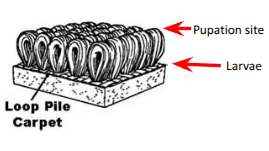
Traditional Insecticdes for Fleas
Chlorpyrifos (over the counter)
Permethrin (pest control operators)
Malathion (evidence of resistance)
Imidacloprid = spot on
Advantage = fleas only
Fipronil = spot on
Frontline = fleas and ticks
Selemectin = spot on for mites
Revolution = worms, fleas, and ticks
Vectors of Murine Typhus
Xenopsylla cheopis (Oriental rat flea)
Nosopsyllus fasciatus (European rat flea)
Ctenocephalides felis (cat flea)
Echidnophaga gallinacea (stick-tight flea)
Leptopsylla segnis (European mouse flea)
Pulex irritans (human flea)
Xenopsylla astia, X. brasiliensis, X. bantorum
Murine Typhus
Caused by Rickettsia typhi (bacterium)
Transmitted to humans via stercorarian transmission
Human rubs infected feces into wound
OR aerosolized feces
Reservoirs:
Rattus rattus (roof rat)
Rattus norvegicus (Norway rat)
Opossums, raccoons, squirrels
Fleas found on these animals may be picked up by pets and transported into homes.
Murine Typhus is an ______.
acute infectious disease
Transmitted from rodents to humans via rat fleas (primarily by feces but direct transmission occurs periodically).
6-12 d intrinsic incubation period
Symptoms: fever backache, headache, bronchitis, confusion, stupor, red eruptions on chest and limbs
Prognosis of Murine Typhus
Victims are humans (4% mortality)
Most severe cases associated with
Delayed diagnosis
Liver and kidney issues
CNS abnormalities
Pulmonary compromise
History of Murine Typhus
Thousands of cases occurred in US during 1940s
Incidence dropped to about 12/yr during 1970s
Today, about 100 human cases reported annually in US
Number increasing; re-emergence in southern California and Texas (past 25 years)
Outbreaks reported in Australia, China, Greece, Israel, Kuwait, Thailand. Recent serosurveys demonstrate high prevalence of rickettsiae in Asia and southern Europe.
Plague
Agent: Yersinia pestis
Bacterium
Victim: Humans and rodents
Vector:
Fleas-Xenopsylla cheopis and many others
Reservoir: Rodent and other small mammals
Roof rat (Rattus rattus)
Norway rat (Rattus norvegicus)
History of Plague
Bacterium discovered by Yersin (Swiss) and Kitasato (Japanese) in 1884 in Hong Kong.
Simond (French) in 1898 proved that fleas were the vector.
Noticed that majority of patients had primary lesion (small blister containing plague bacteria); hypothesized could be related to insect bite.
Plague in the US
Reservoirs: many mammals
Rodents: field mice, deer mice, pack rats, roof rat, Norway rat, cotton rat, wood rat, chipmunks, ground squirrels, tree squirrels, prairie dogs
Rabbits: cottontails
Carnivores:
Dogs get infected, but recover (dog serology used as surveillance tool).
Cats get infected, but may or may not recover.
Vector of Plague
Oriental rat flea (Xenopsylla cheopis)
Flea becomes infected after it has fed on infected rat.
Bacteria multiply in proventriculus (part of stomach) where they form an obstruction.
Flea becomes “blocked” so it becomes hungry.
Repeated attempts to feed, blood is taken from victim, but cannot pass the block and mixes with bacteria.
Infected blood regurgitated into bite wound.
Blocked fleas may live up to 2 weeks. Some die, but none lose the infection.
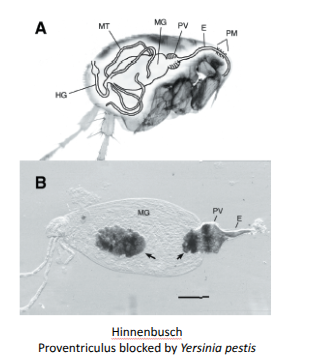
Humans acquire plague from _______.
the bite of infected fleas
Symptoms:
Disease develops rapidly. Fever, headache, exhaustion, delirium 2-3 days post-infection.
Bubo (enlarged and inflamed lymph gland) detectable by 2 days post-infection. These appear in groin area (most common).
Rashes common.
Bubonic plague
Lymph nodes, especially those in groin or armpit area, are swollen and filled with plague bacteria. The swollen lymph node is a “bubo”
Septicemic plague
Body’s defense mechanisms cannot limit the disease to the lymph glands and lymphatic vessels. The infection invades the blood stream. A massive blood poisoning or septicemia occurs.
Pneumonic plague
Most dangerous type – airborne.
Plague bacteria invade pulmonary tissue and a secondary pneumonia occurs (inflammation of lung tissue, solidification of the lung).
At this stage, disease is transmissible as infective drops (sneezing) from the respiratory system.
Medieval physicians wore masks to avoid infection
Plague mortality and treatment
Bubonic plague
25-50% fatality rate
Pneumonic and Septicemic plague
Usually fatal
All people treated with antibiotics (Streptomycin, gentamycin, tetracycline, etc.)
Plague has been a important disease of ______.
humans throughout history
Credited with the collapse of feudalism
Reduced human populations
Four pandemics have been recorded
542 to 600:
Plague of Justinian (Roman emperor)
Nearly worldwide scope (centered in Constantinople, Europe’s largest city during Middle Ages)
1346-1361: “Black Death”, 25 million lives lost worldwide (25% of the population of Europe). Disease spread from Black Sea to Africa, Russia, Europe, China.
1665-1666: “Great Plague of London”, killed 70,000 people out of 450,000 (total population)
Most recent pandemic of plague
Began in the Chinese Province of Yunnan or Burma in the middle of the 19th Century
Reached Canton and Hong Kong in 1884, Calcutta and Bombay in 1896. From these major ports, it spread to every continent.
Outbreaks of Plague was commonly depicted in _______.
European art
Plague and medicine
Protective clothing worn by doctors (early form of
Hazmat suit)
Doctors used to bleed people to get rid of plague
Outbreaks of Plague globally
Cyclic
Flares up periodically on a global scale. Then it retreats to endemic levels.
1,000-3,000 cases/yr.
Most cases since 1990s in Africa
Almost all cases in small towns/villages (not large towns or cities)
Plague in US
Yersinia pestis introduced into West Coast in 1890.
Soon spread to native rodents, especially ground squirrels.
In Oakland, CA (1919), a man hunting ground squirrels contracted the disease and (via pneumonic plague) infected 13 people (12 died).
1925 Los Angeles epidemic
A woman contracted plague (pneumonic), infected 32 relatives/friends, all died.
Thought that human source of infection was domestic rats that had been infected from ground squirrels.
Currently, most cases of rural plague occur in Rocky Mountain states
Cases of Human Plague in the US
Average of 8 human cases/year (range 1-17 cases/year)
Most in summer months
80% of cases are bubonic form
Most cases in western US (one in IL was lab-associated):
Zone 1: Northern New Mexico, northern Arizona, and southern Colorado or
Zone 2: California, southern Oregon, and western Nevada
Plague is considered a likely candidate for ______.
bioterrorism
1998, production of plague vaccine discontinued.
Limited stores available.
Plague ecology in the US
occurs naturally in the western US, especially Arizona, Colorado, Utah, and New Mexico
Bacterium cycles naturally among wild rodent, ground squirrels, prairie dogs, wood rats, and rock squirrels
Epizoonic outbreaks in the US most likely occur during cooler summers after a wetter winter
Humans and domestic animals that are bitten from fleas on dead animals are at risk for contracting plague.
People can also be exposed by handling skins or flesh of infected animals
Cats can become very ill and can spread plague through air droplets while dogs are less likely to be ill